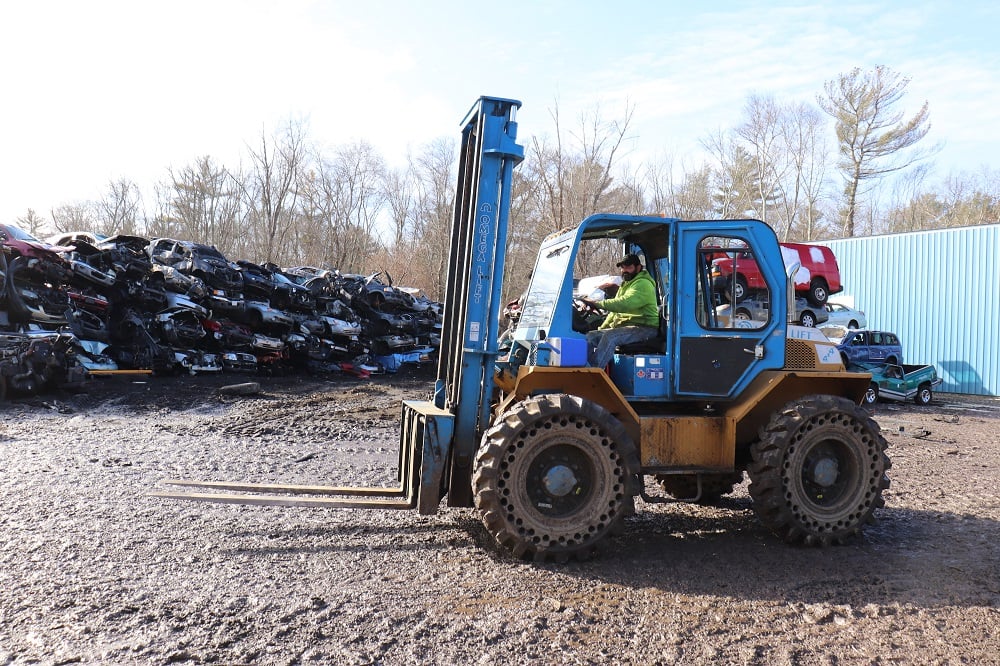Improving Efficiency, Productivity, and Profit with Forklift Tires
Forklifts are an integral piece of equipment in industries ranging from warehousing/distribution to shipping to construction. In recent years, the need to keep forklifts operating at peak performance has grown as businesses increasingly rely on them to move materials. One of the easiest ways to maximize the efficiency and productivity of a forklift by choosing the right tires.
Below are some of the most prominent ways that forklift tires affect a fleet and how an investment in the right tires can yield big returns for your operation.

Choose Application-Specific Tires
It may seem like all forklift tires are the same: black and round. However, everything from a forklift tire’s construction to the compounds that make them to their tread pattern (or lack thereof) can affect their performance, longevity, and return on investment—especially when you consider that tires can account for almost one-third of maintenance costs, which makes them one of the highest expenses associated with operating forklifts.
Equipping forklifts with tires specifically built for their intended application is one of the best ways to ensure you’re getting the most from your machine. The best place to start when choosing an application-specific tire is to select one with the right type of construction—either pneumatic, pneumatic solid, or press-on.
- Pneumatic forklift tires are filled with air and are similar to the tires on your car or truck. Pneumatic tires are ideal for applications where forklifts will travel long distances and face minimal puncture threats.
- Pneumatic solid tires (sometimes also called resilient solid tires) are, as their name implies, made of solid rubber. They’re best for indoor and outdoor applications that demand a combination of ride quality and puncture protection.
- Press-on band tires are solid tires made of a single rubber compound fused to a steel band. These tires excel at indoor applications where the need for stability is paramount.
While there is no one-size-fits-all forklift tire, choosing the right type of tire will put your operation on the path to profit.
Inspect Tires Often
If only maximizing the performance of your forklifts was as easy as bolting on the “right” tires and going about your business. Sadly, that isn’t the case—rather, the more attention you give your tires, the more likely they are to exceed your expectations. Pre-shift forklift inspections tire inspections are mandatory, as catching a potential issue early can save significant expenses and headaches. When inspecting a forklift’s tires, keep an eye out for:
- Splits and cracks
- Chunking and tearing
- Flat spots
- Uneven wear
If you’re running pneumatic forklift tires, it’s also critical to check air pressure. Both under- and over-inflated tires can pose a multitude of problems, including being a safety hazard to operators, causing a machine to underperform, and expediting tire wear. Because changing temperatures cause tire pressure to fluctuate, get in the habit of checking air pressure daily.
Make Tire Maintenance a Priority
It’s tempting to try to squeeze every hour out of your forklift tires, but small issues can quickly become big (and costly) problems. Proactive maintenance and replacing worn tires in a timely manner prevents expensive downtime and helps to ensure the safety of operators. Failing to replace worn-out tires is also bad for your forklift, leading to premature wear on everything from bushings to bearing and resulting in repairs totaling in the thousands.
Provide a Performance Boost
While tires that need replacement can cost you big, well-maintained application-specific tires pay off huge. Good-conditioned tires keep forklifts operating at their best, improving productivity and efficiency, lowering fuel costs, and decreasing fork-heal wear—not to mention avoiding the expense of lost loads, machine damage, and other accident-associated costs that come with a sudden blowout.
There is a lot of buzz around electric forklifts these days—in 2018, they made up 64% of the market—and tires play a vital role in their performance. Choosing a tire with low rolling resistance helps conserve battery life, allowing machines to go longer between charges and improving productivity.
Operator Training
The person manning your machine has an enormous influence over the life of a forklift’s tires and can cause a lot of preventable wear. For example:
- Spinning the tires creates unnecessary heat—the #1 enemy of tires—and leads to premature wear.
- Overloading can lead to cracks and increase the odds of a blowout.
- Excessive speeds create heat buildup and shorten lifespan.
- Quick starts and stops unnecessarily strain tires and expedite wear.
- Aggressive cornering causes uneven wear.
In addition, inattentive and improper use of a forklift can lead to damage to items like racks, curbs, and the machine itself. Spending time training operators and reinforcing good habits is simply good for your tires, and good for your business.
Our Offerings
Outfitting your forklift tires is a common cause of cost overruns and can hurt your business’s bottom line. This is why Yokohama Off-Highway Tires America, Inc. has an application-specific forklift tire for almost every type of job and terrain a forklift faces—from pneumatic to pneumatic solid to press-on. Contact your local dealer or rep to learn more about how our forklift tires can help hoist your profits.

